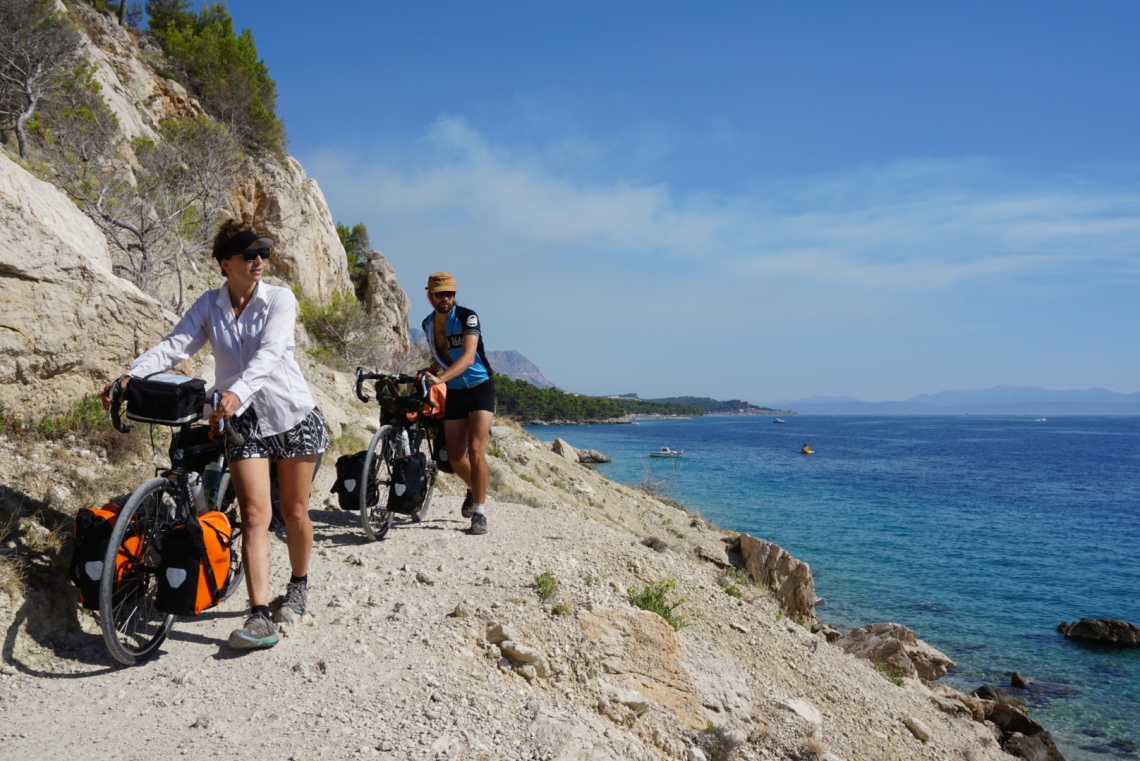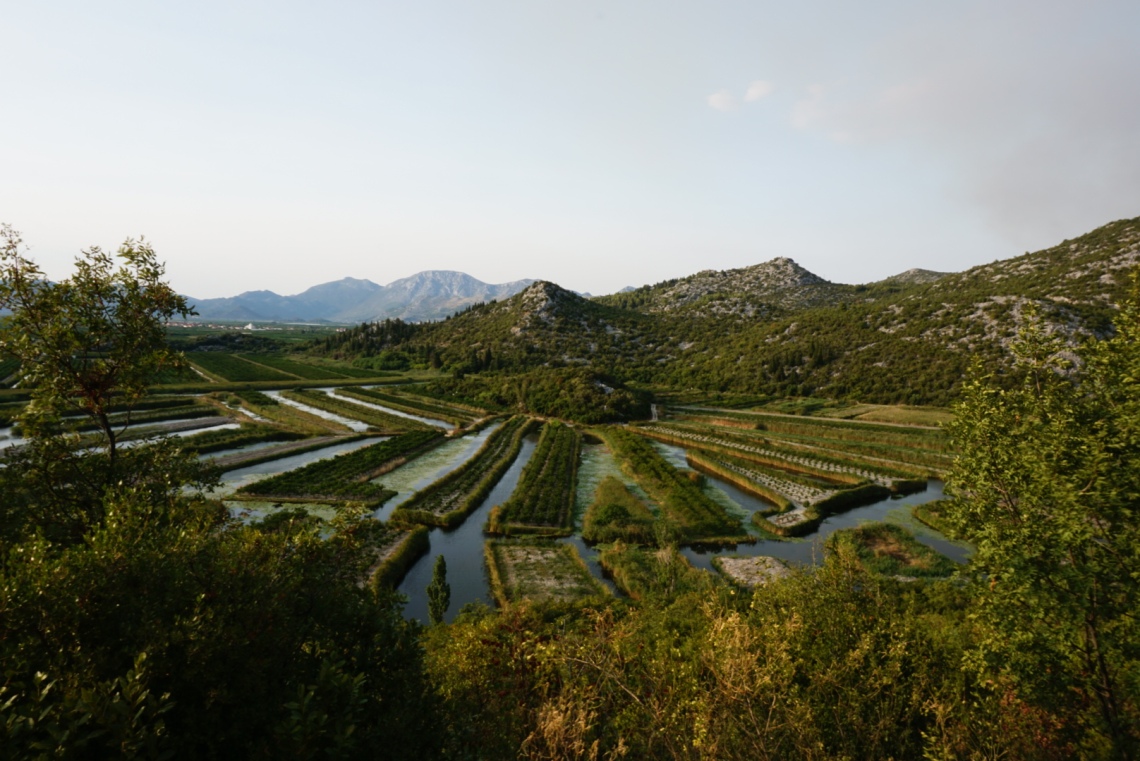An adventure of Angela Mimica and Christian Juica. Un Otro Camino.
This project consist in traveling by bike, observe, and document the transition between protected and non-protected landscapes in the European Mediterranean. Using the comprehensive approach of ‘biocultural diversity’ promoted by UNESCO, we want to understand how different cultural contexts approach to nature, to conservation, and how their landscapes support biodiversity. We are riding along the North coast of the Mediterranean Sea from Dubrovnik to Lisbon observing, photographing, drawing, talking with people, and of course, having fun.
This project is possible thanks to the generous and amazing support of the Department of Landscape Architecture and Environmental Planning UC Berkeley through the Geraldine Knight Scott Fellowship, and the Center of European Studies UC Berkeley through the Portuguese Studies Pinto Award, both given to Angela after her graduation of the Master in Landscape Architecture and Environmental Planning.
Why by bike

Bike touring is much more than a mean of transportation: the speed of 15 km/hr, allow us to observe all the details that are missed when riding a car –a flower at the edge of the road, subtle changes in the slope, the change in temperature crossing a stream. The landscape is perceived with all the senses; a biker is aware of the shade, aspect, changes in the wind direction, the temperature, and humidity. A landscape that by car is passed in few minutes, by bike is observed during hours or days. At the same time opposite to walking, by bike a person can traverse great distances in one day.
Many of the challenges in planning are not at the top level of public policies or plans, but at the bottom level of locals problems, traditions, and culture. On-ground details like clearing some forest to get sun in winter, a fence for cattle, vacation houses located at the edge of the river, or wild mammals threatened by domestic dogs; can make all the difference in the ecosystem functions and how biodiversity is supported.
Yes, it is a lot. We have done shorter long-distance trips: 1390 km of the Carretera Austral in Chile and 2135 km of the Pacific Coast in Canada-USA. But you know what? After a while you get used to it. Resting at night is enough for the body to recover. If you start feeling tedius, just stop for a few days and you are with a recovered mood. That is why some people just bike for years. This project will cover around 4000 km. We have 5 months; plenty of time.
Why the Mediterranean

The Mediterranean biome, with a rich biodiversity is widely recognized as a global conservation priority. That is why we make national parks and protected areas. In the field of planning, there is a kind of new consensus in the importance of conservation of biodiversity outside of protected areas, especially in Mediterranean ecosystems where climate and coastal conditions make them highly desirable human habitats. They are perfect for agriculture, nice weather for living, beautiful landscapes for tourism.
Mediterranean biome is one of the rarest of the Earth’s thirteen terrestrial biomes covering a mere 2% of the Earth’s land surface, but over a 20% of Earth’s plants are found in this biome. Only a 4.3% of the biome is in formally protected areas, and being a suitable climate for living and for agriculture, it seems very hard to increase that area. However, in regions where traditional practices have evolved through centuries, like the European Mediterranean, protected areas are surrounded by a rural or semi-rural matrix that in some cases support high levels of biodiversity. This rich matrix are threatened by replacement with industrial high intensive agriculture and urban growth. In these areas, biodiversity is linked to the structure of a cultural landscape that urge to be recognized.
According to UNESCO and the Convention of Biological Diversity “More research focusing on the links between cultural and biological diversity at the landscape level is needed”. They propose the paradigm of biocultural diversity to understand those links in an integrated system. This project is framed within that new perspective, describing both cultural and biological elements of the landscape along transects that pass by protected areas. The extension of the study will give a valuable comparison among a broad spectrum of cultures.
Regions to study
This adventure will follow the EuroVelo 8 from Croatia to Portugal, that follows the Mediterranean border alterning coastal with inland routes. It crosses 32 protected areas in 5 regions:
Croatia Adriatic Coast
Risnjak National Park
Sjeverni Mountain Biosphere Reserve
Paklenica National Park
Malostonski zaljev Special Reserve
North Italy: Po River Basin
Ente di Gestione delle Aree Protette della Collina Torinese
Parco Regionale Oglio Sud
Parco Regionale Veneto del Delta del Po
Biotopo Palude del Fiume Cavana
Reserva Naturale del Monte Lanaro
French Mediterranean Coast
Paratge Natural l Albera
Narbonnaise en Méditerranée Natural Regional Park
Gorfer du Gardon Biosphere Reserve
Camargue Natural Regional Park
Parc natural regional du Verdon
Parc National du Mercantour
Mediterranean Coast of Spain
Sierras de Tejeda y Almijara Natural Park
Cabo de Gata-Níjar Biosphere Reserve
Parque Natural de Serra Gelada
Parc Natural de la Marjal de Oliva-Pego and Parc del Montgo
Parque Natural Sierra de Irta
Parc Natural del Delta de l’Ebre Biosphere Reserve
Cubelles Parque Natural Foix
Parc Natural del Garraf
Delta del Llobregat
Montseny Biosphere Reserve
South Portugal and Atlantic Coast of Spain
Arrabida Natural Park
Estuario do Sado Natural Reserve
Suroeste_Alentejano y_Costa Vicentina Natural Park.
Parque Natural do Vale do Guadiana
National Park Donana Biosphere Reserve
Natural Park Los Alcornocales Biosphere Reserve
Estrecho Natural Park
Questions that guide the study
How is the landscape in the protected areas for conservation of biodiversity along the North Coast of the Mediterranean?
How are the transitions between protected landscapes and rural landscapes in each Mediterranean region? How is supported biodiversity in these transitions?
What is the contribution of cultural aspects and local practices to the support of biodiversity? What similarities and differences can be found along the North Coast of the Mediterranean?
These can be seen as ambitious questions, especially in concern to biodiversity if they was intended to be answered from a scientific accurate perspective. That would require deep, site-specific, long and expensive research identifying and inventorying vegetal and animal species. Instead, this project cover a broad spectrum of biocultural landscapes that have in common the same climate and biome observing and describing the landscape elements in light of these research questions. We expect to cross rural regions that support biodiversity as much as the protected zones; like the agro-silvo-pastoral Portuguese landscape, the rice planted deltas of the Spanish Coast, or the vineyards in South France. Nevertheless, this may not be true for all the Mediterranean Coast; for sure in areas where biodiversity is threaten by intensive land-uses, existing protected areas are critical and this will be evident in the transition between those intensive land-uses and the protected areas.
Outcomes
We will be documenting our experience and observations through photography, drawings, sections, transects. There is not a defined fixed scale: probably each landscape, each situation will have their particular scale. This will have to be flexible. Biketouring has to be flexible.
Relevant Literature
Agnoletti, Mauro. “Rural Landscape, Nature Conservation and Culture: Some Notes on Research Trends and Management Approaches from a (Southern) European Perspective.” Landscape and Urban Planning 126 (June 2014): 66–73. doi:10.1016/j.landurbplan.2014.02.012.
Bignal, Eric M., David I. McCracken, and Heather Corrie. “Defining European Low-Intensity Farming Systems: The Nature of Farming.” Farming on the Edge: The Nature of Traditional Farmland in Europe. Joint Nature Conservation Committee, Peterborough, 1995, 29–37.
Correia, Teresa Pinto. “Threatened Landscape in Alentejo, Portugal: The ‘montado’ and Other ‘agro-Silvo-Pastoral’ Systems.” Landscape and Urban Planning 24, no. 1 (July 1, 1993): 43–48. doi:10.1016/0169-2046(93)90081-N.
Cox, Robin L., and Emma C. Underwood. “The Importance of Conserving Biodiversity Outside of Protected Areas in Mediterranean Ecosystems.” PLOS ONE 6, no. 1 (July 1, 2011): e14508. doi:10.1371/journal.pone.0014508.
Giner, Salvador Calatayud. “Tierras Inundadas. El Cultivo Del Arroz En La España Contemporánea (1800–1936)<a href=‘#fn01’><span class=‘sup’>1</span></a>.” Revista de Historia Economica – Journal of Iberian and Latin American Economic History 20, no. 1 (March 2002): 39–80. doi:10.1017/S0212610900009666.
Plieninger, Tobias, Franz Höchtl, and Theo Spek. “Traditional Land-Use and Nature Conservation in European Rural Landscapes.” Environmental Science & Policy, European Rural Landscapes: Land-use, biodiversity, and conservation, 9, no. 4 (June 2006): 317–21. doi:10.1016/j.envsci.2006.03.001.
Santos, Katherine C., Joan Pino, Ferran Rodà, Maria Guirado, and Josep Ribas. “Beyond the Reserves: The Role of Non-Protected Rural Areas for Avifauna Conservation in the Area of Barcelona (NE of Spain).” Landscape and Urban Planning 84, no. 2 (February 6, 2008): 140–51. doi:10.1016/j.landurbplan.2007.07.004.UNESCO. “1st European Conference for the Implementation of the UNESCO -‐SCBD Joint Programme on Biological and Cultural Diversity Linking Biological and Cultural Diversity in Europe,” 2014. https://www.protectedplanet.net/
http://www.eurovelo.com


Nice trip !! I wish you the best my friends , a big hug from Chile
Me gustaLe gusta a 1 persona
Thanks, gracias!!! Un abrazo y saludos a Chilito!
Me gustaMe gusta